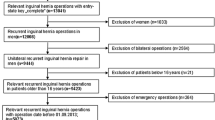Abstract
Background
The purpose of the present randomized trial was to compare the Jean Rives (JR) technique and the laparoscopic totally extraperitoneal (TEP) repair for the treatment of primary inguinal hernias with respect to operating time, hospital stay, sick leave, chronic pain and recurrences after a follow-up of 10 years.
Methods
110 patients with primary inguinal hernia were randomized to either a JR repair (53 patients) or to a laparoscopic (TEP) repair (57 patients). All the interventions were exclusively realized by two experienced surgeons. Follow-up examinations were performed after 1, 6 months, 1, 5 and 10 years.
Results
Both groups were identical concerning age and hernia type, which were type II and type IIIa according to Nyhus classification. No significant difference was found concerning hospital stay, chronic pain and recurrences. The operating time was significantly lower in JR group, whereas the sick leave was significantly in favor of TEP group.
Conclusion
Jean Rives technique is a relatively easy technique to perform, requires shorter operating time when compared to laparoscopic TEP technique. JR technique should be taken into consideration while planning surgical treatment of inguinal hernia.
Similar content being viewed by others
References
Avisse C, Palot JP, Flament JB (1993–1994) Traitement des hernies de l’aine par la technique de Jean Rives Remplacement du fascia transversalis par une prothese de Dacron. Chirurgie 119: 362–365
Stoppa R (2000) Traitement par voie prépéritonéale des hernies de l’aine de l’adulte. Encycl Medico Chir Tech Chir 1:40–115
Wantz GE (1993–1994) Une technique de hernioplastie propéritonéale Le renforcement unilatéral du sac viscéral par grande prothése de Mersiléne. Chirurgie 119:321–326
Amid PK, Shulman AG, Lichtenstein IL, Bocchi P (1995) Opération < tension-free > de Lichtenstein pour hernie inguinale sous anesthésie locale. J Chir (Paris) 132(2):61–66
Nordin P, Bartelmess P, Jansson C, Svensson C, Edlund G (2002) Randomized trial of Lichtenstein versus Shouldice hernia repair in general surgical practice. BJS 89:45–49
Richer JP, Carretier M, Chansigaud JP, Scepi M, Kamina P, Barbier J (1993) Les formations solides de la région de l’aine et la chirurgie herniaire. Lyon Chir 89(6):1302–1313
Koninger J, Redecke J, Butters M (2004) Chronic pain after hernia repair: a randomized trial comparing Shouldice, Lichtenstein and TAPP. Langenbecks Arch Surg 389(5):361–365
Roth JS, Johnson JO, Hazey JW, Pofahl WE (2004) Current laparoscopic inguinal hernia repair. Curr Surg 61(1):53–56
Muldoon RL, Marchant K, Johnson DD, Yoder GG, Read RC, Hauer-Jensen M (2004) Lichtenstein vs anterior preperitoneal prosthetic mesh placement in open inguinal hernia repair: a prospective, randomized trial. Hernia 8(2):98–103. doi:10.1007/s10029-003-0174-5
Forte A, D’Urso A, Palumbo P, Lo Storto G, Gallinaro LS, Bezzi M, Beltrami V (2003) Inguinal hernioplasty: the gold standard of hernia repair. Hernia 7(1):35–38
Antoniou SA, Pointner R, Granderath FA (2014) Current treatment concepts for groin hernia. Langenbecks Arch Surg 399(5):553–558
Vrijland WW, Van den Tol MP, Luijendijk RW et al (2002) Randomized clinical trial of non-mesh versus mesh repair of primary inguinal hernia. BJS 89:293–297
Paganini AM, Lezoche E, Carle F, Carlei F, Favretti F, Feliciotti F, Gesuita R, Guerrieri M, Lomanto D, Nardovino M, Panti M, Ribichini P, Sarli L, Sottili M, Tamburini A, Taschieri A (1998) A randomized controlled clinical study of laparoscopic vs open tension-free inguinal hernia repair. Surg Endosc 12(7):979–986
Liem MS, van der Graaf Y, van Steensel CJ, Boelhouwer RU, Clevers GJ, Meijer WS, Stassen LP, Vente JP, Weidema WF, Schrijvers AJ, van Vroonhoven TJ (1997) Comparison of conventional anterior surgery and laparoscopic surgery for inguinal hernia repair. Engl J Med 336(22):1541–1547
Wright DM, Kennedy A, Baxter JN, Fullarton GM, Fife LM, Sunderland GT, O’Dwyer PJ (1996) Early outcome after open versus extraperitoneal endoscopic tension-free hernioplasty a randomized clinical trial. Surgery 119(5):552–557
Zieren J, Zieren HU, Jacobi CA, Wenger FA, Müller JM (1998) Prospective randomized study comparing laparoscopic and open tension-free inguinalhernia repair with Shouldice operation. Am J Surg 175(4):330–333
Sajid, Craciunas L, Singh KK, Sains P, Baig MK (2013) Open transinguinal preperitoneal mesh repair of inguinal hernia: a targeted systematic review and meta-analysis of published randomized controlled trials. Gastroenterol Rep (Oxf) 1(2):127–137. doi:10.1093/gastro/got002 (Epub 2013 Apr 5)
Cavazzola LT, Rosen MJ (2013) Laparoscopic versus open inguinal hernia repair. Surg Clin North Am 93(5):1269–1279
Acknowledgement
The authors specially thank Senocak M., Professor of Biostatistics for his kindly help in statistical analysis of the present study.
Conflict of interest
KT declares no conflict of interest, YSS declares no conflict of interest, HB declares no conflict of interest, OK declares no conflict of interest, GU declares no conflict of interest, EG declares no conflict of interest, MK declares no conflict of interest.
Author information
Authors and Affiliations
Corresponding author
Rights and permissions
About this article
Cite this article
Tomaoglu, K., Sarı, Y.S., Bektas, H. et al. Prospective randomized clinical trial of Jean Rives technique versus laparoscopic TEP repair for primary inguinal hernia: 10-year follow-up. Hernia 19, 383–387 (2015). https://doi.org/10.1007/s10029-015-1350-0
Received:
Accepted:
Published:
Issue Date:
DOI: https://doi.org/10.1007/s10029-015-1350-0




